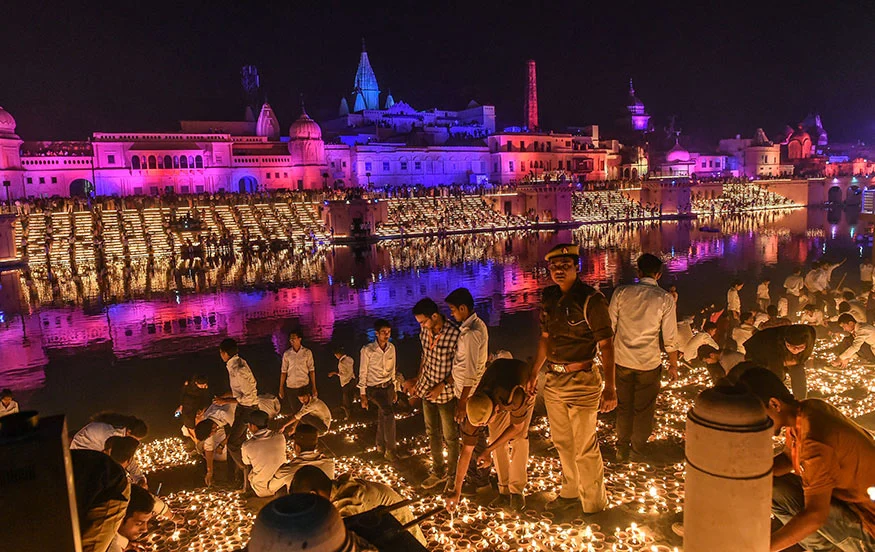Table of Contents:
- Introduction to Ayodhya’s Cultural Heritage Walks
- Key Destinations and Landmarks
- The Stories and Legends of Ayodhya
- Experiencing Local Life and Traditions
- Best Time to Undertake the Walk
- What to Bring and Wear
- Engaging with Local Artisans and Craftsmen
- FAQs for Travelers
1. Introduction to Ayodhya’s Cultural Heritage Walks
Ayodhya, a city imbued with deep cultural and religious significance, offers an immersive walking experience for those interested in exploring its rich heritage. Walking tours in Ayodhya allow visitors to experience the city’s vibrant history firsthand, tracing the steps of legends and discovering hidden gems. These walks are not just tours; they are time capsules that transport you to the heart of India’s cultural and spiritual ethos.
- Walking tours in Ayodhya offer an immersive historical experience.
- They are like time capsules into India’s cultural and spiritual heritage.
2. Key Destinations and Landmarks
A typical cultural heritage walk in Ayodhya includes visits to significant landmarks such as the Ram Janmabhoomi temple, Hanuman Garhi, and the Sarayu River. Each of these destinations has its own unique story and significance, contributing to the rich tapestry of Ayodhya’s history. The walk may also include lesser-known sites, each with its charm and tales.
- Key landmarks include Ram Janmabhoomi, Hanuman Garhi, and Sarayu River.
- The tour often includes lesser-known sites with unique stories.
3. The Stories and Legends of Ayodhya
Ayodhya’s heritage walks are not just about seeing the sights but also about hearing the stories and legends associated with them. Guides often share tales from the Ramayana, local folklore, and historical anecdotes that bring these ancient sites to life. This storytelling aspect adds depth and context to the physical experience of the walk.
- Guides share tales from the Ramayana and local folklore.
- Storytelling adds depth to the experience of the walk.
4. Experiencing Local Life and Traditions
These walking tours also offer a glimpse into the everyday life and traditions of Ayodhya’s residents. Visitors get to see local bazaars, interact with residents, and observe daily rituals and practices. This interaction provides a deeper understanding of the city’s living cultural heritage.
- Opportunity to see local bazaars and interact with residents.
- Observing daily rituals offers insights into the living cultural heritage.
5. Best Time to Undertake the Walk
The best time for a cultural heritage walk in Ayodhya is either in the early morning or late afternoon to avoid the heat. The cooler temperatures during these times make the walk more comfortable and allow for a more leisurely exploration. Additionally, the soft light of morning or evening adds a magical quality to the city’s ancient architecture.
- Early morning or late afternoon are ideal times to avoid the heat.
- Cooler temperatures make for a more comfortable walk.
6. What to Bring and Wear
Comfort is key when embarking on a walking tour. It is advisable to wear comfortable footwear and light, modest clothing suitable for walking and respectful of local customs. Carrying water, a hat or an umbrella, and a small backpack for essentials is also recommended.
- Wear comfortable footwear and light, modest clothing.
- Carry water, a hat or umbrella, and a small backpack.
7. Engaging with Local Artisans and Craftsmen
Many cultural walks in Ayodhya include interactions with local artisans and craftsmen. Visitors have the opportunity to witness traditional crafts, purchase unique handmade items, and learn about the skills and traditions that have been passed down through generations.
- Interact with local artisans and craftsmen.
- Witness traditional crafts and purchase unique handmade items.
8. FAQs for Travelers
- What are the must-visit sites on a cultural heritage walk in Ayodhya?
- Key sites include Ram Janmabhoomi, Hanuman Garhi, and the Sarayu River.
- How long does a typical walking tour last?
- Most tours last about 2-3 hours.
- Do I need a guide for the cultural walk?
- While not mandatory, a guide can enhance the experience with insightful stories and historical context.
- Is the walking tour physically demanding?
- The walk is generally moderate, but it’s important to be in comfortable attire and footwear.
- Are there specific times of the year best for these walks?
- The walks can be undertaken year-round, but cooler months are more comfortable.
- Can I interact with locals during the walk?
- Yes, there are opportunities to interact with locals and observe their daily life.
- Are photography and videography allowed during the walk?
- Yes, but it’s advisable to ask for permission before photographing individuals.
- Can I buy local handicrafts during the walk?
- Yes, there are opportunities to buy handicrafts directly from artisans.
Conclusion: A cultural heritage walk in Ayodhya is more than just a tour; it’s an enriching journey through the heart of one of India’s most ancient and revered cities. It offers an intimate glimpse into the rich tapestry of history, spirituality, and everyday life that defines Ayodhya. From majestic temples to bustling markets and tranquil riverbanks, each step unveils a new layer of Ayodhya’s timeless allure, making it a must-do experience for anyone seeking to connect with India’s profound cultural and spiritual roots.
- A cultural heritage walk in Ayodhya offers an intimate experience of the city’s history and spirituality.
- It’s an essential activity for those looking to delve deep into India’s rich cultural fabric.


